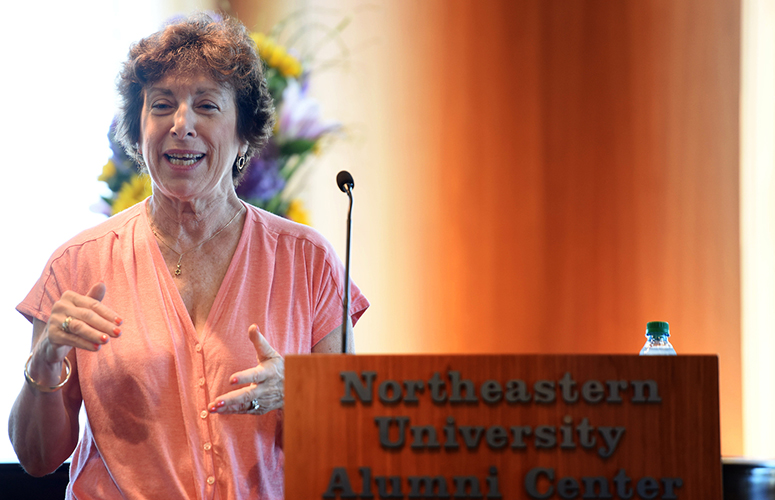National Institute of Environmental Health Sciences head lauds Northeastern’s interdisciplinary approach

“You can’t change your genes, but you can change your environment.”
So said Linda Birnbaum, director of the National Institutes of Health’s National Institute of Environmental Health Sciences, during her forward-looking talk Monday morning at Northeastern.
Faculty researchers and staff from Northeastern as well other area higher education institutions filled the Alumni Center for Birnbaum’s talk, titled “Our Environment, Our Health,” to learn about the philosophy and strategy driving the wide range of the NIEHS’s research and funding activities.
Northeastern, Birnham noted, is making a significant contribution to the institute’s latest goals as part of the multi-country study Zika in Infants and Pregnancy, or ZIP.
You cannot do environmental health work if you don’t work with the community.
— Linda Birnbaum, director, National Institute of Environmental Health Sciences
Northeastern professor Akram N. Alshawabkeh and colleagues recently received an NIEHS grant to collect data and biological specimens from 450 pregnant women in Puerto Rico—the first ZIP study site—to examine the risk of Zika infection among babies of infected mothers and to assess the risk of birth defects and neurodevelopment disorders, such a microcephaly, among them. The funding supplements an earlier NIEHS grant the team received for its Puerto Rico Testsite for Exploring Contamination Threats, or PROTECT, program, directed by Alshawabkeh, which has been following 200 of those pregnant women to assess the contribution of environmental exposure to phthalates and chlorinated volatile organic contaminants, or cVOCs, to Puerto Rico’s high rate of preterm birth.
All told, the ZIP study, which is supported by several organizations, aims to enroll 10,000 women ages 15 years and older in several sites in Brazil, Colombia, Central America, and other areas where local transmission of the virus is prevalent.
“You cannot do environmental health work if you don’t work with the community,” said Birnbaum, who lauded Northeastern, with its emphasis on interdisciplinary research and practice, for doing just that.
“A bad start…lasts a lifetime”
In her talk, Birnbaum stressed the NIEHS commitment to understanding the interaction of genetic susceptibility and environmental exposure across the lifespan—from before conception to old age, among males and females alike.

Linda Birnbaum, director of the National Institute of Environmental Health Sciences, discusses “Our Environment, Our Health” at Northeastern. Photo by Matthew Modoono/Northeastern University
She described agency programs that look at the gene-environment dynamic in all its complexity, investigating not only the effect of chemicals such as persistent organic pollutants and Bisphenol A, also known as BPA, but also agents in food, the bacteria in our guts and on our skin, and emotional states including stress and anxiety.
“We live in a soup,” she said, noting that not only those in identified high-risk areas are affected. “Environmental exposures are ubiquitous.”
The potential outcomes from those exposures—based on epidemiological studies with humans, with cells in the lab, and using animal models—run the gamut. Among them are obesity, diabetes, metabolic disease, asthma, congenital heart defects, behavioral disorders, breast cancer, and ADHD.
What can researchers and educators do to help? “Work with clinicians in areas of prevention,” she said, noting, for example, the high levels of lead found not just in the water in Flint, Michigan, but also in paint in many homes. Develop new tools for detection and analysis, as well as outside-the-box animal models, such as zebrafish, to understand the genetic-environmental mechanisms driving the disorders.
Finally, in this time of low levels of funding, she said, work with staff at the NEIHS to fashion your research proposals. “Call us up. Let us guide you.” Consider Zika, she said. “There is something going on with the virus and environmental contaminants. We provided supplemental funding to the PROTECT Center to initiate ZIP in Puerto Rico.”





